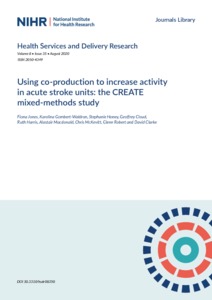Jones, F; Gombert-Waldron, K; Honey, S; Cloud, G; Harris, R; Macdonald, A; McKevitt, C; Robert, G; Clarke, D
(2020)
Using co-production to increase activity in acute stroke units: the CREATE mixed-methods study.
Health and Social Care Delivery Research, 8 (35).
ISSN 2755-0060
https://doi.org/10.3310/hsdr08350
SGUL Authors: Jones, Fiona
![[img]](https://openaccess.sgul.ac.uk/115291/1.hassmallThumbnailVersion/3033711.pdf)  Preview |
|
PDF
Published Version
Available under License ["licenses_description_publisher" not defined].
Download (14MB)
| Preview
|
Abstract
<h4>Background</h4>Stroke is the most common neurological disability in the UK. Any activity contributes to recovery, but stroke patients can be inactive for > 60% of their waking hours. This problem remains, despite organisational changes and targeted interventions. A new approach to addressing post-stroke inactivity is needed. Experience-based co-design has successfully initiated improvements for patients and staff in other acute settings. Experience-based co-design uses observational fieldwork and filmed narratives with patients to trigger different conversations and interactions between patients and staff to improve health-care services.<h4>Objectives</h4>To complete a rapid evidence synthesis of the efficacy and effectiveness of co-production as an approach to quality improvement in acute health-care settings; to evaluate the feasibility and impact of patients, carers and staff co-producing and implementing interventions to increase supervised and independent therapeutic patient activity in acute stroke units; and to understand the experience of participating in experience-based co-design and whether or not interventions developed and implemented in two units could transfer to two additional units using an accelerated experience-based co-design cycle.<h4>Design</h4>A mixed-methods case comparison using interviews, observations, behavioural mapping and self-report surveys (patient-reported outcome measure/patient-reported experience measure) pre and post implementation of experience-based co-design cycles, and a process evaluation informed by normalisation process theory.<h4>Setting</h4>The setting was two stroke units (acute and rehabilitation) in London and two in Yorkshire.<h4>Participants</h4>In total, 130 staff, 76 stroke patients and 47 carers took part.<h4>Findings</h4>The rapid evidence synthesis showed a lack of rigorous evaluation of co-produced interventions in acute health care, and the need for a robust critique of co-production approaches. Interviews and observations (365 hours) identified that it was feasible to co-produce and implement interventions to increase activity in priority areas including ‘space’ (environment), ‘activity’ and, to a lesser extent, ‘communication’. Patients and families reported benefits from participating in co-design and perceived that they were equal and valued members. Staff perceived that experience-based co-design provided a positive experience, was a valuable improvement approach and led to increased activity opportunities. Observations and interviews confirmed the use of new social spaces and increased activity opportunities. However, staff interactions remained largely task focused, with limited focus on enabling patient activity. Behavioural mapping indicated a mixed pattern of activity pre and post implementation of co-designed changes. Patient-reported outcome measure/patient-reported experience measure response rates were low, at 12–38%; pre- and post-experience-based co-design cohorts reported dependency, emotional and social limitations consistent with national statistics. Post-experience-based co-design patient-reported experience measure data indicated that more respondents reported that they had ‘enough things to do in their free time’. The use of experience-based co-design – full and accelerated – legitimised and supported co-production activity. Staff, patients and families played a pivotal role in intervention co-design. All participants recognised that increased activity should be embedded in everyday routines and in work on stroke units.<h4>Limitations</h4>Communication by staff that enabled patient activity was challenging to initiate and sustain.<h4>Conclusions</h4>It was feasible to implement experience-based co-design in stroke units. This resulted in some positive changes in unit environments and increased activity opportunities for patients. There was no discernible difference in experiences or outcomes between full and accelerated experience-based co-design. Future work should consider multiple ways to embed increased patient activity into everyday routines in stroke units.<h4>Funding</h4>This project was funded by the National Institute for Health Research (NIHR) Health Services and Delivery Research programme and will be published in full in Health Services and Delivery Research; Vol. 8, No. 35. See the NIHR Journals Library website for further project information.
| Item Type: |
Article
|
| Additional Information: |
© Queen’s Printer and Controller of HMSO 2020. This work was produced by Jones et al. under the terms of a commissioning contract issued by the Secretary of State for Health and Social Care. This issue may be freely reproduced for the purposes of private research and study and extracts (or indeed, the full report) may be included in professional journals provided that suitable acknowledgement is made and the reproduction is not associated with any form of advertising. Applications for commercial reproduction should be addressed to: NIHR Journals Library, National Institute for Health Research, Evaluation, Trials and Studies Coordinating Centre, Alpha House, University of Southampton Science Park, Southampton SO16 7NS, UK. |
| SGUL Research Institute / Research Centre: |
Academic Structure > Population Health Research Institute (INPH) |
| Journal or Publication Title: |
Health and Social Care Delivery Research |
| ISSN: |
2755-0060 |
| Language: |
eng |
| Dates: |
| Date | Event |
|---|
| 8 September 2020 | Published |
|
| Publisher License: |
Publisher's own licence |
| Projects: |
|
| URI: |
https://openaccess.sgul.ac.uk/id/eprint/115291 |
| Publisher's version: |
https://doi.org/10.3310/hsdr08350 |
Statistics
Item downloaded times since 03 Apr 2023.
Actions (login required)
 |
Edit Item |


